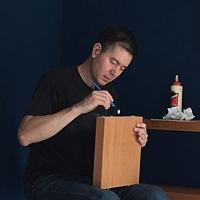Share your craft projects
Make new craft buddies
Ask craft questions
Blog your craft journey

Ron Stewart
860 posts
and
24 followers
in about 3 years
in about 3 years
More from Ron Stewart
Mini Tetrahedral Tensegrity Table Details #4: Cutting the Pyramid Segments
This is
part 4
in a
10 part
series:
Mini Tetrahedral Tensegrity Table Details
Finally, I was ready to start cutting the side segments, starting with the top ends. I clamped the template to the sled with its vertical edge aligned with the side of the sled and made the cuts.



Cutting the base ends was similar, but trickier. I clamped the template so its bottom edge aligned with the sled. The problem was that the blade wanted to push the stock out of the cradle. To deal with that, I used a clamp to push a small scrap block against the stock. If I had to do this again, I'd cut the base ends first. If the stock moved and I had to re-cut, I'd have a little extra length on the opposite end to correct the problem.

With that done, I had a full set of side segments, with some spares.

I verified the segments' lengths with the 1:1 printout, and they looked good.

I wasn't finished with the side segments yet, though. Note the detail at the top of the template drawing.

In order to make the sides meet at a point at the top, I needed to bevel the sides of their tips. I decided not to try to cut them with the table saw blade beveled 30 degrees. I was afraid of tear-out on the narrow ends.
Instead, I beveled the blade, unplugged the saw, and placed a medium-grit sanding disk on the blade. Then, using the same cutting jig, I slowly sanded the bevel, sometimes by moving the sled forward and back, sometimes by rotating the blade with my hand, until the bevel reached the center.
Instead, I beveled the blade, unplugged the saw, and placed a medium-grit sanding disk on the blade. Then, using the same cutting jig, I slowly sanded the bevel, sometimes by moving the sled forward and back, sometimes by rotating the blade with my hand, until the bevel reached the center.

Then I flipped the jig and sanded the other side.

It took ages, but it worked. I wish I had one of those sanding disks that installs in place of a saw blade. I suspect that would have worked better (faster, certainly). Some of the segment ends were slightly rounded, but I was sure I could deal with that during/after gluing the side segments.

With the side segments complete, I moved on to the base segments. Compared to the sides, it was a cakewalk. I could actually rest the stock flat on the table, and all I needed was a beveled blade (19.5 degrees again) and my miter gauge set to 30 degrees.

I did have to use a block to keep the stock flat on the table.

The hardest part was making sure the stock wasn't upside down, so the bevels didn't run the wrong way. (Anyone who has ever installed crown molding probably understands.)
I verified almost every cut. The value of the base cutting template became apparent very quickly.

I had to move the gauge to the other side of the blade (and I think flip the stock upside) down to cut the opposite ends.

Aside from the potential confusion, it was not difficult, and I soon had a full set of base segments (and a spare).

You have no idea how happy I was to see these dry test fits. (Maybe you do, given that I took four photos…)




I was almost ready to start gluing the pyramids together. But first, I had to solve another problem: deciding how I was going to attach the wire that connects the inner peaks of the two pyramids.








